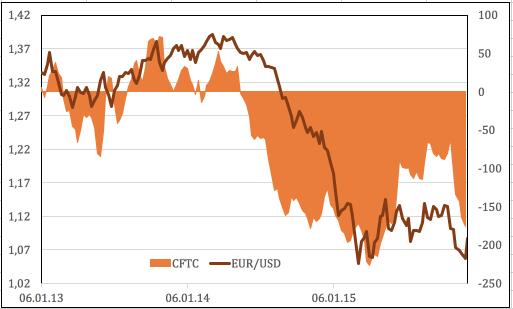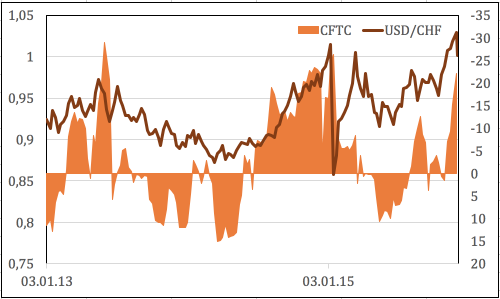The SNB’s expected December 10 rate cuts have already been priced in to the Swiss Franc. The central bank’s failure to do more than the market expected resulted in a stronger CHF. Growing uncertainty over the Fed’s 2016 monetary policy is a bullish factor for the franc. As they watched the euro strengthen following the ECB’s meeting, SNB representatives rubbed their hands in glee. However, by the start of the Asian FOREX session, the franc was already recovering from its wounds. Now, Bern is back to square one, once again feverishly wondering what it can do. The European Central Bank was unable to satisfy investors, only cutting deposit rates from -0.2% to -0.3% and extending its quantitative easing program to March 2017, increasing the latter to €360 billion. The markets saw neither increased monthly purchases, nor cuts to the refinancing rate, nor the removal of the minimum yield on bonds purchased by the ECB. As a result, EUR/CHF prices soared to their highest since mid-October, but they did not stay at that level. The synchronized EUR/USD and USD/CHF dynamics over the last month and a half suggest that it is not only the ECB’s expansionary fiscal policy that is priced into the euro, but also that franc prices have already taken an interest rate cut from -0.75% to -1.25% into account. Such an outcome to the December 10 meeting is predicted by Bloomberg experts.
Topics:
Dmitry Demidenko considers the following as important: CHF, Monetary Assessment, newsletter, SNB, Swiss Franc
This could be interesting, too:
investrends.ch writes SNB schreibt 2024 definitiven Gewinn von über 80 Milliarden Franken
Nachrichten Ticker - www.finanzen.ch writes Die Performance der Kryptowährungen in KW 9: Das hat sich bei Bitcoin, Ether & Co. getan
Nachrichten Ticker - www.finanzen.ch writes Wer verbirgt sich hinter der Ethereum-Technologie?
Martin Hartmann writes Eine Analyse nach den Lehren von Milton Friedman
- The SNB’s expected December 10 rate cuts have already been priced in to the Swiss Franc.
- The central bank’s failure to do more than the market expected resulted in a stronger CHF.
- Growing uncertainty over the Fed’s 2016 monetary policy is a bullish factor for the franc.
As they watched the euro strengthen following the ECB’s meeting, SNB representatives rubbed their hands in glee. However, by the start of the Asian FOREX session, the franc was already recovering from its wounds. Now, Bern is back to square one, once again feverishly wondering what it can do. The European Central Bank was unable to satisfy investors, only cutting deposit rates from -0.2% to -0.3% and extending its quantitative easing program to March 2017, increasing the latter to €360 billion. The markets saw neither increased monthly purchases, nor cuts to the refinancing rate, nor the removal of the minimum yield on bonds purchased by the ECB. As a result, EUR/CHF prices soared to their highest since mid-October, but they did not stay at that level.
The synchronized EUR/USD and USD/CHF dynamics over the last month and a half suggest that it is not only the ECB’s expansionary fiscal policy that is priced into the euro, but also that franc prices have already taken an interest rate cut from -0.75% to -1.25% into account. Such an outcome to the December 10 meeting is predicted by Bloomberg experts. Alas, while the Swiss National Bank was in a particularly difficult position before December 3, secretly praying that its Frankfurt colleagues would fail to impress, it is precisely this scenario that has trapped it in a corner. If it does not lower its target LIBOR rate, the franc will follow in the euro’s footsteps — something its economy, anemic from currency revaluation, will not withstand. According to the third quarter summary, its GDP stagnated despite forecasts of 0.2% q/q growth. A rise in consumer spending was not enough to compensate for the decline in construction investment and slowdown in exports.

Source: CFTC, Trading Economics

Source: CFTC, Trading Economics
The situation is becoming increasingly complicated due to displays of uncertainty regarding future monetary policy. While the date of the first Fed funds rate hike has already been practically decided, the question of when the Federal Reserve’s monetary policy cycle will continue remains unanswered. This uncertainty is leading to a growing demand for haven assets, such as the yen and the franc, and worsens the headache for the SNB, which keeps tirelessly insisting that its currency is overvalued.
It is unlikely that currency intervention or the removal of exemptions on sight deposits would inspire any grand feats from swissy bears. Drastic measures are needed, but it is unlikely that the central bank has enough courage to implement them. As a result, the franc could strengthen against other G10 currencies. However, the weak economy and negative rates in the Swiss bond market should ultimately have their effect, so corrections in USD/CHF and GBP/CHF should be used to sell FXF and buy UUP and FXB.
